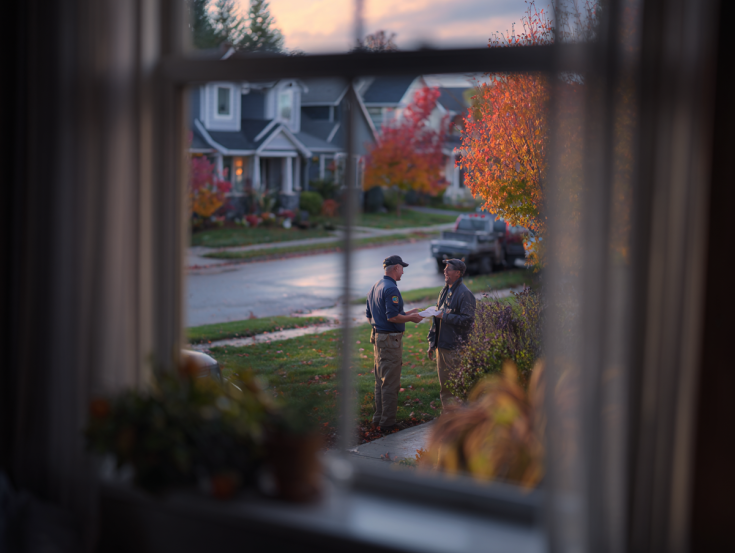Running a roofing company means juggling crews, managing leads, and keeping the business pipeline full—all while dealing with the reality that homeowner interest ebbs and flows with the seasons. When business is booming during spring and summer storm seasons, creating marketing content is the last thing on your mind. But when those quiet winter months hit, you’re scrambling for leads.
What if you could break this feast-or-famine cycle with a year-round content plan that works as hard as you do? Having a seasonal marketing calendar isn’t just convenient—it’s essential for maintaining a consistent lead flow and maximizing your marketing budget effectively.
Let’s explore how to build a practical, season-by-season content marketing strategy that keeps your roofing business top-of-mind all year long.
Key Takeaways
-
Plan content quarterly instead of monthly to save time and maintain consistency during your busiest periods. Create content in batches during slow seasons for use throughout your peak times.
-
Align content with seasonal homeowner needs like spring storm preparedness, summer maintenance tips, fall weatherproofing, and winter inspection benefits to remain relevant year-round.
-
Weather-based content performs 67% better than generic roofing content, as homeowners search for urgent solutions when facing immediate problems like leaks or storm damage.
-
Tax season (January-April) presents a unique opportunity for marketing home improvement investments when homeowners have refund checks in hand—create content highlighting roof replacement as a smart investment.
-
Invest in seasonal SEO strategies by building seasonal content 30-45 days before peak search trends hit. According to Google Trends, “roof repair” searches spike in May-July, providing a clear content planning timeline.
-
Consider professional content marketing support to maintain consistency throughout the year, potentially saving money through annual pre-payment while freeing up your time to focus on operations.
What Content Topics Perform Best During Each Season?
Content Follows Weather Patterns and Homeowner Priorities
The roofing industry is uniquely tied to seasonal patterns. According to Google Trends data, searches for “roof repair” consistently spike during late spring and early summer months, with another smaller peak in early fall. This creates a natural roadmap for your content calendar.
Weather events drive urgent roofing needs—Verisk reports roof insurance claims topped $30 billion in 2024, with the majority occurring during spring and summer storm seasons. This data isn’t just interesting; it’s your content planning goldmine.
Here’s a season-by-season breakdown of high-performing content topics:
Spring (March-May)
- Storm damage identification guides
- Emergency repair preparation checklists
- Hail damage assessment tools
- Spring roof maintenance checklists
- Tax refund investment ideas (roof repairs/replacement)
Summer (June-August)
- Heat damage prevention tips
- Energy-efficient roofing options
- Summer storm preparedness
- DIY inspection guides for homeowners
- Before/after project showcases
Fall (September-November)
- Winterization checklists
- Gutter maintenance guides
- Fall inspection importance
- End-of-year tax deduction opportunities
- Last-chance repair content before winter
Winter (December-February)
- Ice dam prevention
- Winter damage warning signs
- Planning for spring projects
- Financing options for upcoming repairs
- Educational content about different roofing materials
Remember, the key is creating content that solves seasonal problems homeowners are actively experiencing. A blog post about ice dams in July won’t gain traction, but in December, it becomes exactly what homeowners are searching for.
| Season | Top Content Topics | Key Messaging Focus | Best Channels |
|---|---|---|---|
| Spring | Storm damage, tax refund investments, repair guides | Urgency, preparation, investment | Email, Google Ads, Facebook |
| Summer | Heat efficiency, storm recovery, maintenance | Energy savings, quick response | Google Business Profile, Instagram (project photos) |
| Fall | Winterization, gutter services, inspection checklists | Prevention, protection, peace of mind | Email, Facebook, YouTube |
| Winter | Ice damage, planning, educational content | Education, future planning, budget-friendly | Blog, Email, Instagram Stories |
When planning your content calendar, analyze local weather patterns and align your content accordingly. Areas with earlier tornado seasons or late hurricane threats will need adjusted timelines.
Need help staying consistent with your seasonal content strategy? Get a free SEO audit to identify the seasonal keywords that matter most for your market.

How Can I Create a Year-Round Content Calendar That Won’t Overwhelm Me?
Batch Content Creation During Slow Periods
The biggest mistake roofing business owners make with content marketing is trying to create content during their busiest operational seasons. This approach inevitably fails because when you’re managing multiple crews and jobs, writing blog posts falls to the bottom of your priority list.
Instead, use this proven approach:
-
Plan quarterly, not weekly or monthly. Block out 4 major content planning sessions per year during your slower periods.
-
Batch similar content types together. Create all your how-to videos in one session, write multiple blog posts in another, and design your seasonal infographics in a third.
-
Build a content bank. During winter (typically your slowest season), create storm-related content for the upcoming spring. During fall, develop your winter content.
Here’s a practical quarterly planning template you can use:
Winter Planning (Dec-Feb)
- Create spring storm season content (blogs, emails, social posts)
- Plan tax season promotion materials
- Develop photo/video strategy for upcoming projects
Spring Planning (Mar-May)
- Develop summer project showcase materials
- Create fall maintenance content
- Update website seasonal landing pages
Summer Planning (June-Aug)
- Develop fall/winter preparation content
- Create winter emergency response materials
- Plan end-of-year promotions
Fall Planning (Sept-Nov)
- Develop winter educational content
- Create tax planning materials
- Plan spring campaign strategy
This approach ensures you always have content ready before you need it. For example, your “Spring Storm Preparation” blog should be published in late February—not when storms are already hitting in April and you’re too busy to write.
-- QUARTERLY CONTENT CHECKLIST --
For each season, prepare:
□ 3-5 blog posts (seasonal topics)
□ 2 downloadable resources (checklists, guides)
□ 8-12 social media posts
□ 1 seasonal email campaign (3-4 emails)
□ 1 seasonal promotion or offer
□ 1 customer success story/case study
Remember that consistency beats perfection. A simple, sustainable content plan you can actually execute is far better than an elaborate strategy that falls apart during busy season.
“The process is simpler than most contractors think,” explains the team at JobNimbus Marketing. “Many of our roofing clients find they can plan an entire quarter’s content in just one focused work session.”
How Do I Use Tax Season in My Content Marketing?
Leverage the Annual Refund Opportunity
Tax season (January through April) presents a unique opportunity that many roofing companies completely overlook in their marketing calendars. During this period, homeowners receive tax refunds and are actively considering how to invest that money.
According to IRS data, the average tax refund in 2024 was approximately $3,011—a significant sum that could cover a down payment on a roof replacement or fully fund smaller repairs. This creates a perfect alignment of homeowner needs and your services.
Here’s how to capitalize on tax season in your content marketing:
1. Create Tax Season-Specific Content:
- “How a New Roof Increases Home Value: Smart Tax Refund Investments”
- “Tax Refund Calculator: Will Your Return Cover These Essential Roof Repairs?”
- “5 Reasons Roofing Repairs Top the List of Smart Tax Refund Investments”
2. Highlight Financial Benefits:
- Energy efficiency savings from new roofing materials
- Potential insurance premium reductions
- Home value appreciation statistics
- Protection from costly emergency repairs
3. Develop Tax Season-Specific Offers:
- Tax refund matching (up to a certain amount)
- Special financing for projects booked during tax season
- Free upgrades for tax-season bookings
This “Tax Refund Calculator” content template shows how you can turn tax season into a conversion opportunity:
| Typical Tax Refund Range | What This Could Cover | Long-Term Value |
|---|---|---|
| $1,000-$2,000 | Emergency repairs, partial reroofing, gutter replacement | Prevents water damage averaging $7,000+ in repairs |
| $2,000-$3,500 | Minor roof replacement, premium materials upgrade | Adds 5-7% to home value, reduces energy costs by 15% |
| $3,500+ | Significant down payment on complete reroof | Adds 10%+ to home value, eliminates repair costs for 20+ years |
“We found that creating tax season content in January led to a 34% increase in spring project bookings,” notes a case study by Improve and Grow. “Homeowners were already planning how to use their refunds, and roofing content helped direct that decision.”
The key timing for tax season content is:
- Early January: Plant the seed about roofing as a refund investment
- February-March: Peak tax filing time—offer specific promotions
- April: Last-chance messaging around deadlines and scheduling
By creating this content during your slow winter months, you’ll be perfectly positioned when homeowners receive those refund checks.
How Early Should I Create Seasonal Content for SEO Benefits?
Plan 30-45 Days Ahead of Seasonal Search Trends
SEO success depends on timing—having your seasonal content fully indexed and ranking before homeowners start searching. Google Trends data shows clear patterns in roofing-related searches, with “roof repair” searches beginning to climb in March, peaking from May through July, and showing a smaller surge in September.
This creates a clear timeline for your content creation schedule.
The 30-45 day rule is critical for seasonal SEO success. According to Search Engine Journal, “Content should be published at least 30-45 days before the seasonal peak to allow search engines to properly index, evaluate, and rank the content.”
Let’s break down the optimal timing:
For Spring Storm Season (peak searches: May-June)
- Create content: January-February
- Publish content: March-April
- Content peaks in rankings: May-June
For Summer Projects (peak searches: June-August)
- Create content: March-April
- Publish content: May
- Content peaks in rankings: June-August
For Fall Maintenance (peak searches: September-October)
- Create content: July
- Publish content: August
- Content peaks in rankings: September-October
For Winter Protection (peak searches: November-December)
- Create content: September
- Publish content: October
- Content peaks in rankings: November-December
This approach aligns perfectly with Google’s Helpful Content Update, which rewards websites that demonstrate expertise and seasonal relevance. When homeowners search for “hail damage roof repair” during storm season, Google favors sites that have recently updated, detailed content on that exact topic.
| Seasonal Keyword | Peak Search Month(s) | Optimal Publish Date | Content Creation Timeline |
|---|---|---|---|
| Roof storm damage | May-June | Early April | February-March |
| Roof replacement cost | June-July | Early May | March-April |
| Roof leak repair | April & September | March & August | January & June |
| Roof winterization | October-November | September | July-August |
| Ice dam prevention | December-January | November | September |
Consider using Google’s free keyword planning tools to identify seasonal patterns specific to your service area. Hail season starts earlier in Texas than in Minnesota, and hurricane-related keywords only matter in certain regions.
“The roofing companies that win at seasonal SEO aren’t necessarily creating better content—they’re creating timely content,” explains the JobNimbus Marketing team in their guide on timing roofing campaigns for maximum impact.

What Types of Seasonal Content Drive the Most Leads?
Match Content Types to Seasonal Homeowner Concerns
Not all content types perform equally throughout the year. Matching content formats to seasonal homeowner mindsets dramatically improves conversion rates.
Based on analysis of high-performing roofing content across seasons, here’s what works best:
Spring: Emergency & Action-Oriented Content
- Checklist-style blog posts (storm preparedness, damage identification)
- Short-form videos showing damage assessment
- Infographics comparing minor vs. major damage
- Downloadable emergency contact cards
During storm season, homeowners want quick, actionable information when they fear damage. Long-form educational content won’t perform as well during this urgent phase.
Summer: Visual Showcase Content
- Before/after project galleries
- Drone footage of completed projects
- Customer testimonial videos
- Time-lapse project completions
Summer is when your teams are most visible in neighborhoods, and homeowners are seeing your work. Capitalize on this with visual content that showcases your quality and efficiency.
Fall: Planning & Prevention Content
- Comprehensive guides to winterization
- Cost comparison tools (repair now vs. wait)
- Preventative maintenance checklists
- Winter preparation webinars
Fall content should focus on helping homeowners be proactive before winter arrives, with emphasis on peace of mind and prevention.
Winter: Educational & Value-Building Content
- Detailed material comparison guides
- Long-form educational videos about roofing technology
- Financing and budgeting tools
- Design and visualization tools
Winter is when homeowners have time to research major projects for the coming year. They’re less urgently focused on immediate repairs and more interested in learning about options.
The most successful roofing companies adapt their content types to match these seasonal mindsets. A homeowner searching “emergency roof leak” during a spring storm isn’t going to watch your 15-minute video about roofing materials—they need quick, actionable guidance.
Here’s a suggested seasonal content format distribution:
| Season | Primary Content Types | Average Engagement Time | Call-to-Action Focus |
|---|---|---|---|
| Spring | Checklists, quick guides, emergency resources | 3-5 minutes | Emergency assessment, quick quotes |
| Summer | Visual galleries, project showcases, testimonials | 5-7 minutes | Free estimates, referral requests |
| Fall | Preventative guides, maintenance checklists | 7-10 minutes | Fall inspections, winter prep packages |
| Winter | Educational content, comparison tools, planning resources | 10-15 minutes | Design consultations, early booking discounts |
“We’ve found that content format matters almost as much as the topic itself,” explains a recent case study on roofing leads. “Matching the content type to the homeowner’s mindset in each season increased our conversion rates by over 40%.”
Ready to build a content strategy that converts all year long? Get a free SEO audit to identify your top seasonal opportunities.
How Do I Keep Content Flowing When I’m Too Busy Running My Business?
Professional Content Creation Saves Time and Maintains Consistency
Let’s address the elephant in the room: creating consistent, high-quality marketing content while running a roofing business is overwhelming. During peak season, you’re managing crews, providing estimates, and overseeing projects—content creation invariably falls to the bottom of your priority list.
This is precisely why many successful roofing companies outsource their content marketing. The math is simple: your time is better spent on high-value operational activities and sales, not struggling to write blog posts or create social media content.
Consider these practical approaches to maintaining content quality without sacrificing your core business focus:
Option 1: Batch Creation During Off-Season
- Dedicate 1-2 full days each quarter to create content
- Use templates and repeatable formats
- Schedule everything in advance
- Pros: Lower cost, maintains your voice
- Cons: Takes your focus away from business, often gets delayed
Option 2: Delegate to Team Members
- Assign specific content responsibilities to office staff
- Create simple templates they can follow
- Schedule monthly content review sessions
- Pros: Builds team engagement, distributes workload
- Cons: Inconsistent quality, still requires your oversight
Option 3: Professional Content Marketing Service
- Partner with specialists like JobNimbus Marketing
- Receive consistent, seasonally appropriate content
- Implement comprehensive coverage across channels
- Pros: Professional quality, consistent delivery, expertise
- Cons: Higher investment (though often more cost-effective when calculating your time value)
The investment in professional content marketing often pays for itself when you consider the opportunity cost of your time. An hour spent writing a blog post is an hour not spent closing a $15,000 roof replacement.
Many roofing companies find that paying annually for marketing services in advance during tax season (when cash flow is stronger) provides both discounts and peace of mind for the coming year. This approach aligns perfectly with your seasonal business cycle:
TAX SEASON MARKETING INVESTMENT STRATEGY
□ January: Review previous year's marketing performance
□ February: Select annual marketing package
□ March: Pre-pay annual services for potential discount
□ April-December: Focus on operations while marketing runs consistently
“The contractors who grow most consistently are those who recognize their highest value activities—and delegate the rest,” notes JobNimbus Marketing in their guide on effective year-round roofing marketing.
A complete marketing service typically includes:
- Seasonal blog content (weekly or bi-weekly)
- Google Business Profile optimization
- Reputation management
- Local SEO implementation
- Social media content and management
By investing in professional support, you maintain marketing momentum through all seasons—especially during your busiest periods when lead generation is most valuable.
Weatherproofing Your Marketing Year-Round
Creating a year-round content strategy doesn’t have to be overwhelming. By understanding seasonal patterns, planning ahead for SEO benefits, matching content types to homeowner needs, and considering professional support, you can maintain a consistent marketing presence that drives leads in every season.
Remember these key principles:
- Plan quarterly, not weekly or monthly
- Create content 30-45 days before seasonal peaks
- Use tax season as a unique marketing opportunity
- Match content types to seasonal homeowner mindsets
- Consider professional support to maintain consistency
The roofing companies that thrive year after year aren’t necessarily the ones with the biggest marketing budgets—they’re the ones that maintain consistency regardless of season. Whether you manage your content in-house or partner with professionals, the key is building a sustainable system that works even during your busiest operational periods.
Ready to build a seasonal content strategy that drives leads all year long? Get a free SEO audit to identify your biggest seasonal opportunities and create a practical action plan.
Frequently Asked Questions
Q: How far in advance should I create seasonal content for maximum SEO impact?
A: Create and publish seasonal content 30-45 days before the expected search peak. For example, spring storm content should be published by early March, even though the peak search volume typically occurs in May and June. This gives search engines time to index and rank your content before homeowners start searching in large numbers.
Q: What are the most effective types of content for storm season?
A: During storm season, focus on quick, actionable content: damage identification checklists, emergency response guides, and visual comparisons of minor vs. serious damage. Homeowners during this period want immediate solutions to urgent problems, not lengthy educational content. Videos demonstrating quick inspection techniques are particularly effective.
Q: How can I create content when I’m already overwhelmed running my business?
A: Consider three options: batch creation during slow seasons, delegation to team members using templates, or partnering with a marketing service. Many successful contractors find that outsourcing content creation to experts provides the best return on investment, especially when considering the opportunity cost of your time during busy seasons.
Q: What’s the best way to leverage tax season in my roofing marketing?
A: Create content in January and February highlighting roof repairs or replacement as smart tax refund investments. Develop calculators showing how average refunds (approximately $3,000) can cover specific roofing services, and create special “tax season” promotions like refund matching or additional warranties for projects booked during this period.
Q: Should my content strategy change based on my local climate?
A: Absolutely. Customize your seasonal content calendar based on your local weather patterns and peak seasons. Use Google Trends to analyze when people in your specific market search for roofing services. For example, hurricane-prone regions should adjust their emergency content timing to align with hurricane season, while northern markets need earlier winter preparation content.
Q: Is it worth paying for marketing services annually instead of monthly?
A: Many roofing companies find that annual pre-payment during tax season provides multiple benefits: potential discounts (typically 10-15%), consistent year-round coverage without monthly decisions, and alignment with your cash flow cycles. This approach ensures your marketing continues running during your busiest operational periods when you have the least time to manage it yourself.
Table of Contents
Keep on learnin'
Related Articles


Roofing Referral Program: Why Fall Is the Best Time to Ask


